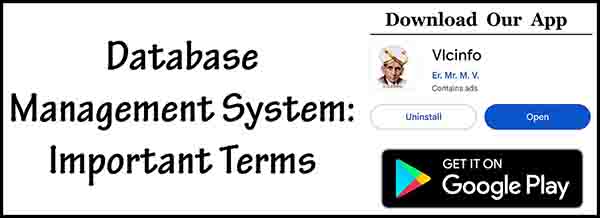Here you will get knowledge about “Database Management System and its Important Terms”. We have described all terms in detail here. You will get complete knowledge about Database Management System here. Keep Visiting – Vlcinfo.
Database Management System And Its Important Terms
1. Database Management System
- A DBMS is a software application which provides interaction with a database.
- It provide interface between the database and the users or applications.
- It store, retrieve, update and manage all data very efficiently and securely.
2. Data
- It is a structured or unstructured information.
- It is stored and managed within a database.
- E.g. text, numbers, dates, images, audios, videos etc.
3. Database
- It is a structured collection of data.
- It is stored and managed using special software.
- It provide centralized repository for storing various data like text, numbers, images and multimedia files.
- It provide efficient storage, retrieval and manipulation.
- It consists one or more tables. Each table contains rows and columns that represent individual records and attributes, respectively.
4. Information
- “Information” is a processed and organized data that has been interpreted or analyzed to provide meaning or context.
5. Metadata
- “Metadata” is a data about data.
- It provides important information about the characteristics of the data stored in a database.
- It manage data assets, facilitating their discovery, interpretation and utilization.
6. Field
- “Field” refers to a single piece of data within a database table.
- Fields are also known as columns or attributes.
- It represents a specific characteristic or property of the entities being stored.
7. Record
- A “record” refers to a complete set of related data or information about a single entity stored in a database table.
- Records are also known as rows or tuples.
8. Data Dictionary
- It is a central repository that contains metadata and detailed descriptions of the data elements.
- It provides information about the structure and properties of the data.
- It helps users to understand and manage the database effectively.
9. Data Warehouse
- It is a specialized database.
- It stores and manages large volumes of data from various sources.
- It is used for data analysis and decision-making processes.
10. Primary Key
- It is a unique identification for each record in a table.
- It establish relationships between tables.
11. Foreign Key
- It is a field in one table that refers to the primary key in another table.
- It establish a relationship between the two tables and support data normalization.
- It ensure consistency and accuracy in the data.
12. Normalization
- It is the process of organizing data in a database efficiently.
- It reducing redundancy and dependency.
- It involves dividing large tables into smaller ones and defining relationships between them.
- It minimize data duplication and improve data integrity.
13. Query
- It is a request for data or information from a database.
- It is generally written in a query language like, SQL (Structured Query Language).
- It performs various operations like inserting, updating or deleting data.
14. Index
- It works like a roadmap.
- It quickly locate and access the desired data and improve query performance.
15. Schema
- It is the structure that defines the organization of data in a database.
- It includes the tables, fields, data types, relationships, constraints and other properties.
16. Transaction
- It is a single unit of work performed within a database management system.
- It consists of one or more database operations (like, read, write) that are treated as a single logical unit.

